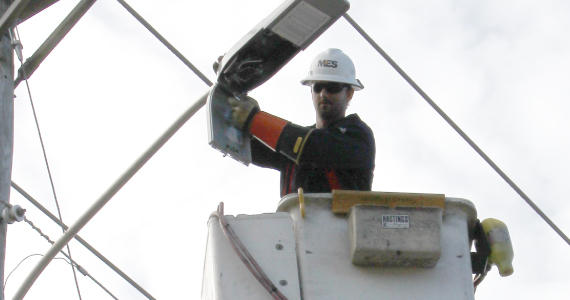McMinnville sees major drop in street lighting load after converting to LEDs
![]() Print this Article | Send to Colleague
Print this Article | Send to Colleague

Public Power Daily
Public Power Weekly Exclusive: McMinnville sees major drop in street lighting load after converting to LEDs
From the June 15, 2015 issue of Public Power Daily
Originally published June 12, 2015
By Jeannine Anderson
News Editor
The public power utility run by the community of McMinnville, Tennessee, recently converted its street lights to light-emitting diodes, or LEDs, and the $1 million project is already paying big dividends in terms of energy savings.
Early this year, with the conversion complete, the McMinnville Electric System noticed a dramatic drop in the amount of electricity needed to light the town's streets. That part of the city’s load plummeted by nearly 50 percent, compared to the same month the year before.
The city believes it is the first city in Tennessee — and also the first in the Tennessee Valley Authority’s seven-state footprint — to make the switch to LED street lights, according to McMinnville Electric System officials.
"As electricity costs go up in the future, the costs will not go up as much" as they would have with the old high-pressure sodium lights because the new LED lights are saving so much energy, said Rodney Boyd, the utility’s general manager, in a June 2 interview with Public Power Weekly. He noted that McMinnville buys its wholesale power from TVA, which has said it expects to raise its wholesale electricity price by 1.5 percent a year for the next seven years.
Switching to the new lights "helps to manage the costs of electricity going forward," Boyd said.
In February 2014, the city’s outdoor lights (street lights and yard lights) consumed 348,314 kilowatt hours of electricity, Boyd said. In February 2015, after the conversion to LED lights, that figure was 183,283 kilowatt hours — a savings of 47 percent.
The new lights are already saving the utility a lot of money in street light maintenance costs, he said. With the old high-pressure sodium bulbs, "we were visiting the lights every two to three years for something," he explained. "Maintenance costs were really adding up," with the city paying $2,200 to $2,300 per month for maintenance on the lights.

Today, with all of those new LEDs, there is virtually no maintenance cost — a savings of roughly $28,000 a year compared to the old lights, Boyd said.
Mayor Haley provided the initial push for LED lights. McMinnville’s mayor, Jimmy Haley, began talking about LEDs about three years ago.
"This was more than changing fixtures — it was a cause near and dear to the heart of the mayor," said Debbie Sain, McMinnville Electric’s manager of marketing and communications, in a written summary describing the project.
She said many people in McMinnville know of Mayor Haley’s "dedication to keeping our town clean," noting that the mayor could be found picking up trash along Main Street or unloading trash bins after the city’s annual summer concert series.
The LED streetlight project was a way "to reduce energy use and reduce the city’s carbon footprint while bringing a better product and value to the citizens of McMinnville," she said. She added that, according to Phillip Burgess of the Tennessee Valley Public Power Association, McMinnville is the first city in the Tennessee Valley to convert its street lighting to LEDs.
When Mayor Haley first began advocating the street light project, the city was reluctant to take it on because of the relatively high cost of the LED lights, said Boyd. "We waited for a couple of years" and kept running the numbers, he said.
While in "wait and see" mode, the utility asked various LED vendors for some of their lights to try out and tested them in various configurations. Those tests were carried out along the street near Boyd’s house. Members of the city government would come over to the general manager’s yard, look around, and compare the various LED luminaires, he said. "We’d talk, and somebody else would pull up" to check out what was going on and perhaps join in the discussion.
It was interesting to see the different brands of LED lights, with their slightly different colorings and different patterns, he said. "We’d move them around — move the one on the end to the middle," and so on, to compare how each light looked in different spots.
